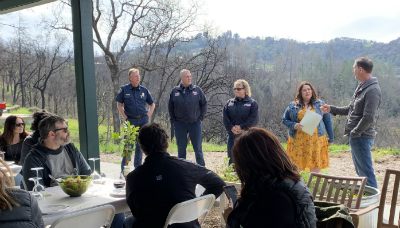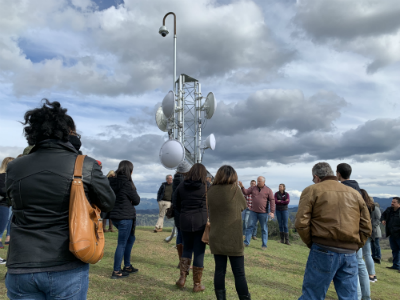CSAC Staff Focus on County Advocacy in Action
Reading the news, looking at maps and watching survivor interviews can only convey a fraction of the horror of escaping a California wildfire. Driving the twisty country roads and standing in the center of a valley imagining the hills on fire provides the true impact of a devastating wildfire. CSAC staff members are committed to getting out of the office and experiencing what is happening in California counties first hand. And at least once a year, we try to visit a county and learn about a policy issue as an entire staff. Last week’s staff retreat and strategic planning session was a perfect example of focusing on county advocacy in action.
 CSAC staff and guests focused on wildfire’s impact
and some of the rebuilding efforts the association helped
champion during a recent visit to Sonoma County. Hosted by the
office of Supervisor and CSAC Second Vice President James Gore,
and narrated by District Director Jenny Chamberlain, last week
staff followed the path of the Tubbs and Nuns fires that claimed
5,100 structures in Sonoma County and 25 lives.
CSAC staff and guests focused on wildfire’s impact
and some of the rebuilding efforts the association helped
champion during a recent visit to Sonoma County. Hosted by the
office of Supervisor and CSAC Second Vice President James Gore,
and narrated by District Director Jenny Chamberlain, last week
staff followed the path of the Tubbs and Nuns fires that claimed
5,100 structures in Sonoma County and 25 lives.
Wildfires and disaster recovery have been a legislative priority for CSAC since the 2017 firestorm. CSAC continues to focus on preparedness and recovery efforts, including the third convening of the CSAC Fire Recovery Summit and Roundtable.
Witnessing resiliency in person, we visited the newly rebuilt and hardened home of Barry and Marlena Hirsch, one of the county’s first residents to return. We also heard from Cyndi Foreman from the Rincon Valley and Windsor Fire Protection District. Foreman recounted her experiences, the lingering concerns of both her staff and residents, as well as the efforts underway to pool and consolidate resources among first responders to improve fire response.
 Next, staff visited the Pepperwood Preserve where we
learned more about the Sonoma County watershed, climate change
monitoring and were treated to panoramic views while visiting two
newly installed fire cameras atop hills at the preserve. Jay
Jasperse with Sonoma County Water Agency explained how these fire
cameras are playing an important role of fire detection, and
emphasized the need for a statewide network of cameras linked to
CalFire and other monitoring and emergency response systems.
Next, staff visited the Pepperwood Preserve where we
learned more about the Sonoma County watershed, climate change
monitoring and were treated to panoramic views while visiting two
newly installed fire cameras atop hills at the preserve. Jay
Jasperse with Sonoma County Water Agency explained how these fire
cameras are playing an important role of fire detection, and
emphasized the need for a statewide network of cameras linked to
CalFire and other monitoring and emergency response systems.
We also met with Jeff Okrepkie, founder of Coffey Strong, a neighborhood nonprofit organized to streamline and simplify efforts to rebuild. Through a system of block captains, collaboration and resiliency, around 120 homes (out of 1,351 destroyed) in Coffey Park are under construction or have already been completed. Comparatively, only 6 of the 1,200 homes destroyed in the Fountaingrove neighborhood are complete.
This deep dive into Sonoma County and wildfire aftermath helped CSAC staff at all levels discover greater meaning in their day-to-day work. The tour and reflection provided the perfect set for the rest of the activities, providing focus and energy for internal team building and a strategic planning session. Special thanks go out to Supervisor Gore and Jenny Chamberlain for helping to coordinate the tour. As wildfires and disasters remain a key legislative priority, there’s just no substitute for seeing first-hand CSAC’s advocacy efforts at work. CSAC has begun a strong partnership with the Governor to make further progress on this issue for all impacted counties this year.











































